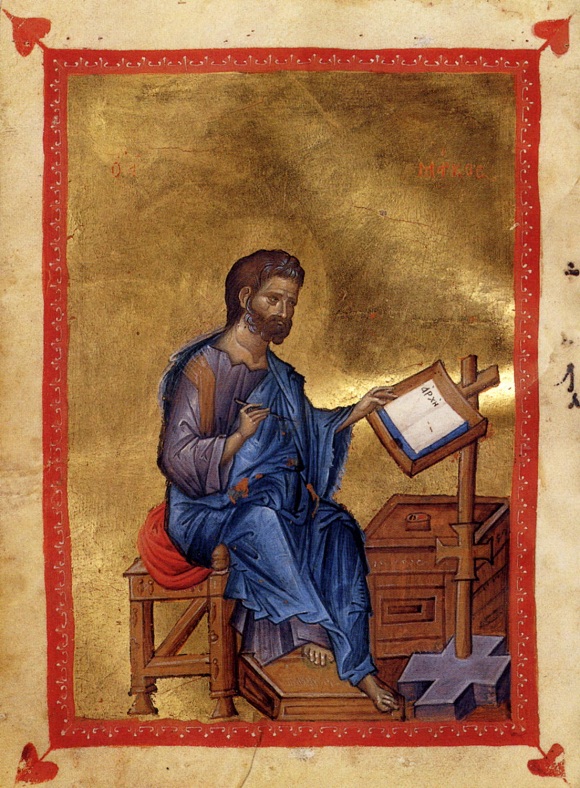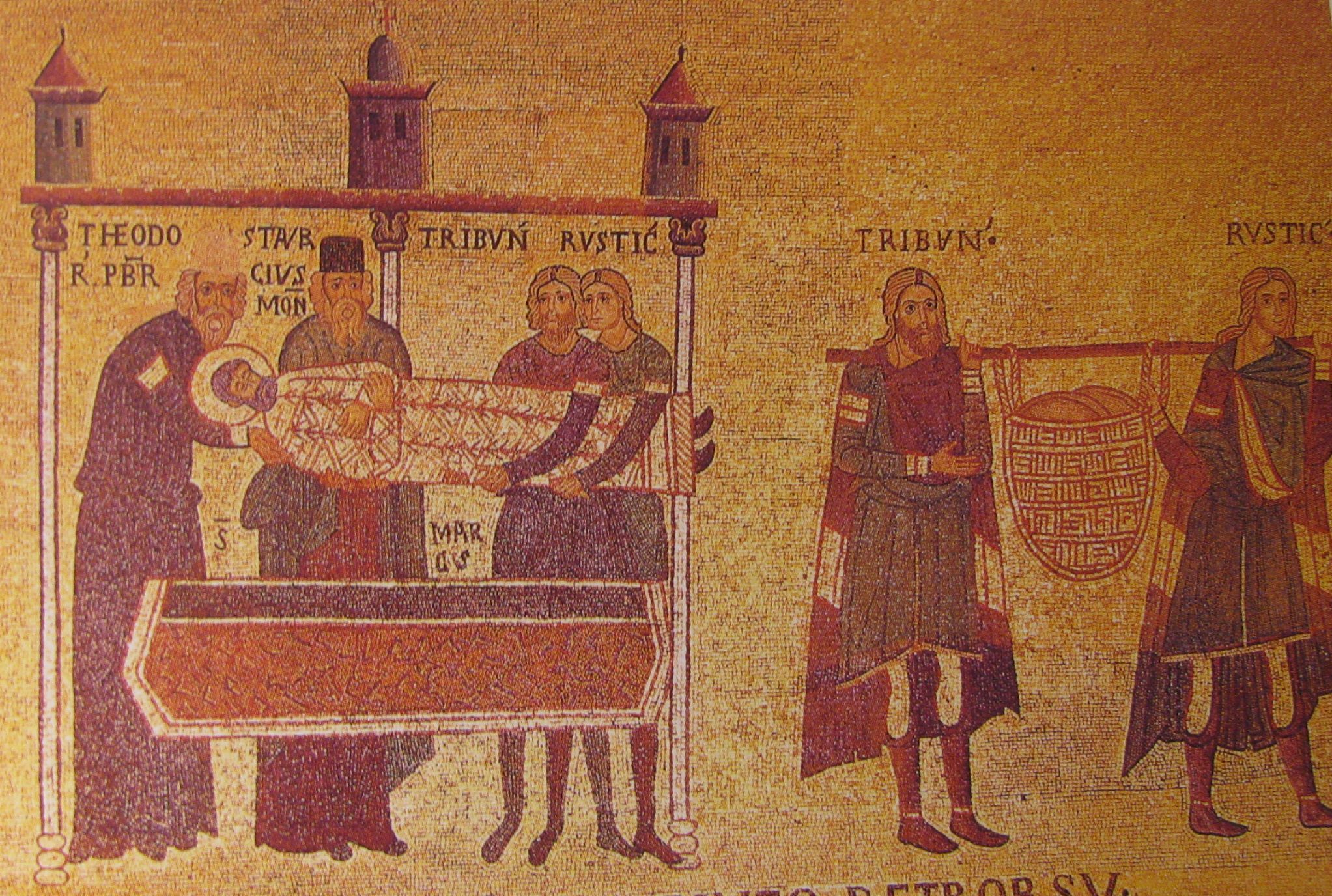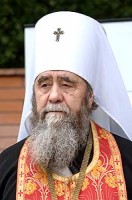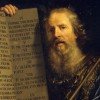“I found that there were four Gospels, and as there were four of them one of the four must be shorter than the others. As I did not expect any good to come from any of the four, I decided to read the shortest one. And there I fell into a trap – as I was to discover many times in the future how cunning God is when He casts His nets in order to catch a fish – because had I read a different Gospel I would have had difficulties. Each Gospel has a certain cultural foundation: Mark, however, wrote exactly for young savages like me – for Roman youngsters. I did not know this – but God knew it and maybe Mark knew it when he wrote more briefly than the others. So I sat down to read. And at this point you will have to trust my word because this cannot be proved… I was sitting and reading, and between the beginning of the first and the beginning of the third chapter of the Gospel according to St. Mark, which I was reading slowly, because the language was unfamiliar to me, I suddenly felt that there, at the other side of the table, stood Christ.” [1]
Thus Metropolitan Anthony (Bloom) describes his first encounter with the New Testament.
 We know even less from the Gospels about the Apostle Mark than we do about Matthew. He says nothing at all about himself, but there is one episode in his Gospel… When Jesus was captured, all forsook Him, and fled. And there followed Him a certain young man, having a linen cloth cast about his naked body; and the young men laid hold of him: And he left the linen cloth, and fled from them naked (14:50-52).
We know even less from the Gospels about the Apostle Mark than we do about Matthew. He says nothing at all about himself, but there is one episode in his Gospel… When Jesus was captured, all forsook Him, and fled. And there followed Him a certain young man, having a linen cloth cast about his naked body; and the young men laid hold of him: And he left the linen cloth, and fled from them naked (14:50-52).
None of the other Evangelists relate this episode, which indeed seems somehow overly comedic at such a tragic moment. It was worth including only if it was of special importance for the author: in all likelihood, Mark is talking about himself here. He was not one of the Twelve Apostles, but he did follow Jesus, perhaps at first out of simply curiosity. He was not present at the Mystical Supper, but was somewhere nearby, probably already asleep. He heard something unusual going on, jumped up, quickly gathered whatever bed linen was within reach, and ran out to look – and there it happened! So he had to run away in shame.
This entirely unheroic episode emphasizes that the future great Apostles were originally anything but great. If they had resolved to follow Jesus, their lives could have changed in a single moment, but they did not change so quickly. Here this curious but timid young man did not immediately become that brave and confident preacher of Christ whom the Church venerates in the person of the Apostle Mark.
What more do we know about him? One can glean some information from the other books of the New Testament. In the Epistle of Paul to the Colossians (4:10), he is mentioned as being the nephew of the Apostle Barnabas, while Peter calls him his son in his First Epistle (5:13). Apparently, the kinship with Barnabas was physical, while that with Peter was spiritual, since he was the latter’s closest disciple at the time.
But we encounter the most interesting mention in Acts (12:12). When Peter was freed from the prison in Jerusalem, he came to the house of Mary the mother of John, whose surname was Mark; where many were gathered together praying. Thus, this young man was living in his mother’s house in Jerusalem, and this house served from the very beginning as a meeting place for the first Christians. Perhaps on the night before the crucifixion it was this house that he slipped out of, wrapped in a linen cloth…
But why does he have two names? This was not uncommon in those days: a young Pharisee by the name of Saul (that is, Sha’ul) will also be called by the Roman name of Paul. In just the same way, a young Jewish man with the common name of John took another common name, this one Roman – apparently this made dealings with non-Jews easier. This is like the princes of ancient Rus’ who, in addition to their Slavic names, also had the Greek names with which they were baptized: Yaroslav the Wise, for instance, was named George.
We read more about this same John-Mark in the Book of Acts. He first accompanied Paul and his uncle Barnabas on their missionary journey, but later returned to Jerusalem. Later Barnabas wanted to take his nephew with him again, but Paul did not agree to go with someone who had already left them once before. As a result, the Apostles divided up: Barnabas and Mark went in one direction, while Paul went in another with his new helper, Silas (15:37-41). This is one of the very few arguments among the Apostles that we encounter in the New Testament. What was this? Was it the same momentary weakness and inconstancy as in the episode with the linen? Or was it something more serious, a matter of principle? We do not know for certain, but the Apostles were also human, with their own weaknesses and differences.
But we do know that John-Mark did not abandon preaching. The Bible does not mention him again, but tradition tells us that Mark’s main place of preaching was Africa. He became a bishop in Alexandria, which was then the principle city of Egypt, although he did not stay in this city only, but travelled throughout the surrounding regions. Mark also went to Rome, where he not only met the Apostle Peter, but became his main helper (for which reason Peter writes of him as his son).
However, with the passage of time, the number of communities grew rapidly, while witnesses, on the contrary, gradually departed from this life. Now the need arose to put into writing the tradition about the life, ministry, death, and Resurrection of Jesus. It was only natural that the principal Apostles would not do this (they had plenty else to do), but rather those who were younger, who might not have know all the details themselves and therefore stood in particular need of a written text for preaching and teaching. The Apostle Mark was such a person.
He not only possessed a Roman name, but in his Gospel he addressed Romans in the broad sense of this word: inhabitants of the entire Empire, who knew little of Israel’s sacred history, prophecy, and the other details to which the Apostle Matthew gave so much attention. Moreover, Mark clearly addressed simple people who were not up on theological subtleties or literary elegance (or perhaps he had not received enough schooling to make use of it). His text is filled with events that follow one another in rapid succession. “Straightaway” is one of this Evangelist’s favorite words (in the first chapter alone, there are seven episodes that begin with this word!).
His sixteen chapters (the shortest Gospel of the four) are divided into two roughly equal parts. The first part tells of the entire earthly life of Jesus Christ up to the point that Peter confessed Him to be Christ, that is, the Messiah (Mark 8:29). Then Marks gives an account of the Transfiguration, when Christ’s stature was revealed to the chosen disciples, and of His Entry into Jerusalem, when everyone in the city received Him as the Messiah. But Christ had already warned His disciples that His agonizing death and Resurrection would soon follow – although it is true that the disciples did not yet understand the full depths of these worlds.
In this Gospel, Christ constantly reproaches His hearers, and especially the Apostles, for their lack of understanding. This, of course, does not mean that they were not smart or clever enough, but rather that their perceptions were banal, that they were unprepared to listen and wonder. Even when Peter confesses Jesus to be the Christ, and the other disciples tacitly agree with him, they continue to expect Him to act according to their own program: to set up His mighty kingdom and make them His ministers. The brothers James and John even rush to occupy the first places ahead of time. This is Christ’s reply to their request to seat them at His right and left hands: Can ye drink of the cup that I drink of? and be baptized with the baptism that I am baptized with? (Mark 10:38). In other words, if you want to sit next to Me, are you ready to follow My path and accept the same sufferings for the sake of preaching the Gospel?
They were then still not ready. Mark tells in detail of the threefold denial of Peter, who had so ardently spoken of his dedication to Jesus – but when the opportunity arose for him to demonstrate this in practice, he said three times that he did not know Him. The human weakness of the Apostles emphasizes the power and majesty of Christ Himself, Who had to overcome not only the open resistance of His enemies, but also the unreliability of His closest friends.
Each of the Evangelists has his own symbol, which hearkens back to the vision of the four angelic beings described by the Prophet Ezekiel in the very beginning of his book. There they accompanied the Lord in His triumphal procession, which is why they were likened to the four Apostles who compiled the written testimony about Christ’s earthly life. The lion was chosen as Mark’s symbol, because he depicted the power and might of Jesus; his text itself, which is filed with energy and motion, resembles a bounding lion. The Evangelist Matthew’s symbol is an angel with a human face, inasmuch as he frequently speaks of the Savior’s human nature. Luke is portrayed by a sacrificial ox, while John, with his lofty theology, is portrayed by an eagle.
Another interesting particularity of the Gospel according to Mark is that it does not have a single ending. After the eighth verse of the sixteenth chapter (this sentence is literally cut off in the middle), some manuscripts contain the version with which we are familiar, others have a very short conclusion, while there are still others that cut off at this point. It is quite possible that Mark himself was unable to finish his book or that the end of his manuscript was lost and one of his disciples later completed the text on his own. In any case, this book arose in the early Church and was accepted as part of Holy Scripture. The Apostle Peter’s account was translated into Greek and recorded by the Apostle Mark, and perhaps not by him alone – but these are details that do not change our approach to this book in any way.
+++
The Apostles, who had once scattered and denied Christ, were still able to follow their Teacher’s footsteps. The day on which the Apostle Mark is commemorated, April 25, is likely the date of his death, which took place in the 60s of the first century. Tradition tells that he was torn to pieces by a mob of enraged pagans that wanted to stop the preaching of the new faith – in vain, as always happens in such cases.
The Apostle’s journey did not stop after his death, however. His body reposed in Alexandria for several centuries, but after Egypt was conquered by Muslims in the middle of the seventh century, the position of Christians became complicated. Churches were everywhere converted into mosques and it was feared that a similar fate would befall the church in which the Apostle’s body lay. At the beginning of the ninth century merchants came to the rescue from a then-unknown city on the distant Adriatic coast, a city called Venice. They took the relics with them and in time built a palatial church that they called San Marco, that is, St. Mark’s Basilica. In order to trick Egyptian customs, they even hid the saint’s body among pig carcasses, since the Muslims disdained touching such things and would not examine such cargo.
Or perhaps they cheated not only the customs agents, but also the Egyptian Christians by simply stealing these relics? This is quite possible, since the Basilica of San Marco was later adorned with treasures taken by the Venetians from Byzantium. And it is perfectly certain that the merchants were motivated not only by piety, but also by political calculation. Venice was then an Italian backwater, but wanted to become a strong, independent state. For this to happen, it was necessary first of all to acquire a powerful heavenly patron. If the city of Rome could take pride in having the chair of the Apostle Peter, then now Venice would have the relics of another Apostle: Mark! From then on, the Venetians began to tell the legend that the Apostle had one been on these islands (the city did not yet exist) and that an angel appeared to him and said: “Peace be upon you, Mark! Here will rest your body.” That is why throughout Venice you can see a lion with an open book. This same lion appeared on the coat of arms, not of Italy, but of Montenegro, along with the Byzantine double-headed eagle, because part of today’s Montenegrin coast once belonged to Venice.
This story was most likely invented by the Venetians themselves to justify their actions, but it demonstrates how closely entwined fact and faction, religious devotion and political calculation were in medieval Christianity. The time would come when another new state, which would be called Rus’, would also choose one of the twelve – Andrew – and begin relating how he had preached Christianity on the future site of Kiev, how he had predicted its glorious future, and even how he had steamed himself in the famous Russian bathhouses. Such stories may not correspond entirely to reality, but they do clearly demonstrate that the faithful have always sought kinship with the Apostles: not only to venerate their memory, but to incorporate them into their family circle, to trace their own kin to them. It is not so important which specific lands were visited by which Apostle twenty centuries ago: it is much more important whether the current inhabitants of these lands follow the path they indicated.
Translator’s note:
[1] “Without Notes” in Metropolitan Anthony of Sourozh, Encounter, tr. Tatiana Wolff (London: Danton, Longman and Todd Ltd, 2005), 197.


















